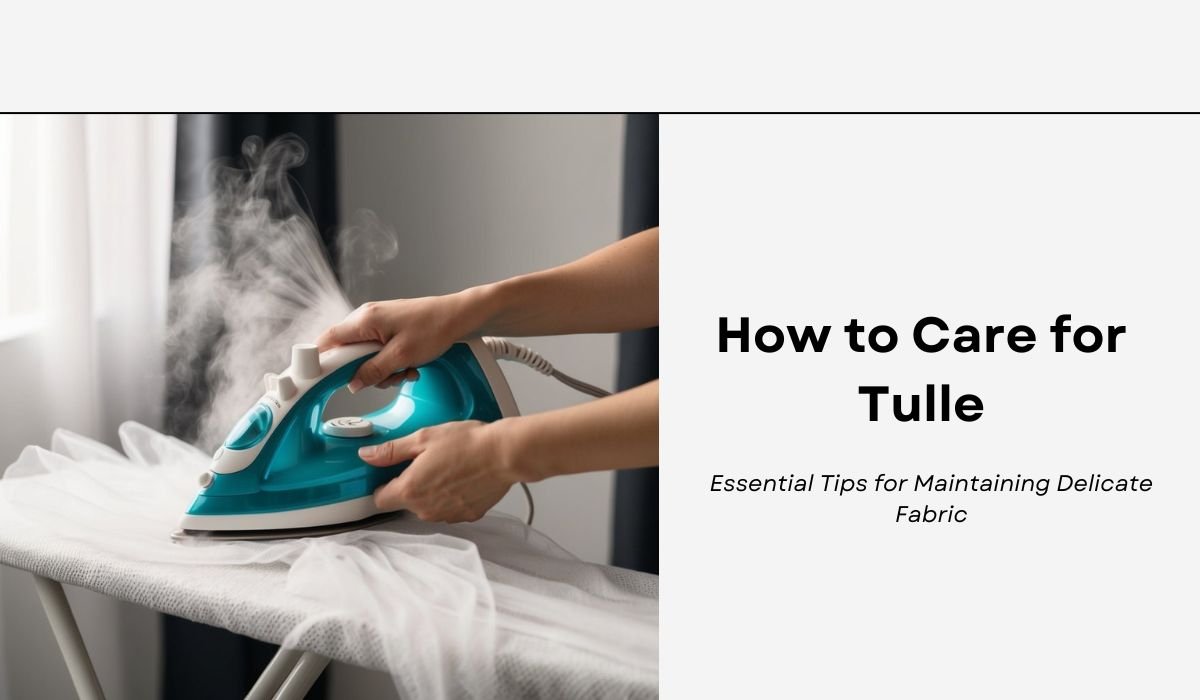Keep Your Ethereal Pieces Perfect: Advice for Preserving the Magic of This Delicate Netting
Tulle, the delicate and ethereal fabric often found in wedding gowns and fancy dresses, requires special care to maintain its beauty. This light, netlike material can easily snag or tear if not handled properly. To care for tulle, gentle hand washing with mild detergent in cold water is the safest method.
For those who own tulle garments, knowing how to clean and store them is crucial. While some sturdy tulle items can be machine washed on a delicate cycle, most benefit from hand washing to avoid damage. Proper drying and storage techniques also play a key role in keeping tulle looking its best for years to come.
Table of Contents
Key Takeaways
- Gentle hand washing with mild detergent is best for most tulle items
- Lay tulle flat to dry and avoid wringing or twisting
- Store tulle carefully to prevent snags and maintain its shape
Understanding Tulle Fabric
Tulle is a lightweight, sheer fabric with a distinctive net-like appearance. It comes in different materials and has unique properties that make it popular for formal wear and decorations.
Types of Tulle
Tulle comes in several varieties based on its fiber content. Silk tulle is soft and luxurious, often used in high-end gowns. Nylon tulle is strong and affordable, making it common in ballet tutus and veils. Polyester tulle offers durability and is frequently used in crafts and decorations.
Cotton tulle has a softer texture and is less shiny than synthetic options. Rayon tulle blends natural and synthetic fibers for a silky feel. Each type has its own care needs and best uses.
Characteristics of Tulle
Tulle stands out for its airy, mesh-like structure. It’s very light and see-through, with small holes that give it a net-like look. This fabric holds its shape well, creating volume in skirts and dresses.
Tulle can be stiff or soft, depending on how it’s made. It comes in many colors and can have different finishes like glitter or embroidery. The fabric’s open weave allows air to flow through easily.
Despite its delicate appearance, tulle can be quite strong. It resists wrinkles and doesn’t fray easily. These traits make it ideal for layering in clothing and decor.
Preparing to Clean Tulle
Before washing tulle, it’s important to check for any damage and identify stains. These steps help prevent further harm to the delicate fabric during cleaning.
Inspecting for Damage
Look closely at the tulle for rips, snags, or loose threads. Hold it up to a light source to spot small tears more easily. Gently run your fingers over the surface to feel for any rough spots.
Pay extra attention to seams and edges. These areas often show wear first. If you find minor damage, mend it before washing. For larger issues, consider professional repair.
Check any embellishments like beads or sequins. Make sure they’re securely attached. Remove loose ones to prevent them from falling off during cleaning.
Identifying Stains
Examine the tulle for any visible stains or discoloration. Common stains include:
- Food or drink spills
- Makeup marks
- Sweat or deodorant residue
- Dirt or mud
Note the type and location of each stain. This helps you choose the right cleaning method. For example, oily stains need different treatment than water-based ones.
Test stain removers on a hidden area first. This prevents unexpected color changes or damage. If unsure about a stain, seek advice from a professional cleaner.
Hand Washing Tulle
Hand washing is the gentlest method for cleaning tulle. It helps keep the delicate fabric in good shape and avoids damage. This process requires care and attention to detail.
Choosing the Right Detergent
Pick a mild detergent for washing tulle. Harsh cleaners can harm the fabric’s fibers. Look for products made for delicate fabrics or baby clothes.
Liquid detergents work well. They dissolve easily in water. Avoid powders that might not rinse out fully. Choose unscented options to prevent strong smells from sticking to the tulle.
Use only a small amount of detergent. Too much soap can leave residue on the fabric. A teaspoon is often enough for a sink full of water.
Washing Techniques
Fill a clean sink or basin with cool or lukewarm water. Hot water can damage tulle. Add the detergent and mix it gently.
Submerge the tulle in the water. Let it soak for 5-10 minutes. This helps loosen dirt.
Gently swish the fabric around. Don’t rub or wring it. This can cause tears or stretching.
Rinse the tulle in clean, cool water. Make sure all soap is gone. Soap left behind can make the fabric stiff.
To dry, lay the tulle flat on a clean towel. Pat it gently with another towel. Don’t twist or squeeze. Let it air dry away from direct heat or sunlight.
Machine Washing Tulle
Machine washing tulle requires care and attention to detail. The right settings and precautions can help protect this delicate fabric.
Setting the Appropriate Cycle
Choose a gentle or delicate cycle for washing tulle. Use cold water to prevent shrinkage and damage. Select a slow spin speed to reduce stress on the fabric.
Add a small amount of mild detergent made for delicates. Avoid harsh soaps or fabric softeners. These can weaken tulle fibers.
Set the water level to low or medium. Too much water can cause tulle to tangle or stretch out of shape.
Protective Measures
Place tulle items in a mesh laundry bag before washing. This stops them from snagging or tangling with other clothes. For extra protection, put the bagged tulle inside a pillowcase.
Turn tulle garments inside out before washing. This protects any decorations on the outside. Remove any pins, brooches, or detachable elements first.
Don’t overload the washing machine. Give tulle plenty of space to move freely. Wash tulle items separately from heavy or rough fabrics.
After washing, remove tulle promptly from the machine. Gently reshape the item while damp. Lay it flat to dry on a clean towel away from direct heat or sunlight.
Drying Tulle
Proper drying is key to maintaining tulle’s shape and texture. Gentle methods help preserve the fabric’s delicate nature and prevent damage.
Air-Drying Strategies
Lay tulle flat to dry. Spread it on a clean, dry towel away from direct sunlight. This prevents stretching and keeps the fabric’s shape intact. For larger pieces, drape tulle over a drying rack or clothesline. Use padded hangers to avoid creases.
Don’t wring or twist tulle when wet. This can damage the delicate fibers. Instead, gently press out excess water with a towel.
For faster drying, use a fan on a low setting. Point it towards the tulle to increase air circulation. This speeds up the process without applying heat.
Avoiding Heat Exposure
Never put tulle in a clothes dryer. The heat and tumbling action can ruin the fabric. It may shrink, melt, or become brittle.
Skip the iron too. High temperatures can damage tulle’s structure. If wrinkles are a problem, try hanging the item in a steamy bathroom. The moisture helps relax the fabric.
For stubborn wrinkles, use a steamer on the lowest setting. Hold it at least 6 inches away from the tulle. Test a small, hidden area first to ensure the fabric can handle the steam.
Ironing Tulle
Ironing tulle requires care and special techniques to avoid damaging the delicate fabric. The right tools and methods can smooth wrinkles safely.
Ironing Techniques
Set the iron to its lowest heat setting. Test a small hidden area first to check for any damage. Use a pressing cloth between the iron and tulle to protect the fabric.
Move the iron in gentle, sweeping motions. Don’t press down hard or leave the iron in one spot too long. For stubborn wrinkles, try using a slightly damp cloth over the tulle.
A handheld steamer works well as an alternative to an iron. Hold it about an inch away from the tulle and move it slowly over wrinkled areas.
For nylon tulle, dampen the fabric slightly before ironing. This helps smooth out wrinkles more easily.
Safety Precautions
Never place an iron directly on tulle. The heat can melt or scorch the fabric. Always use a pressing cloth as a barrier.
Check your iron’s temperature often. If it feels too hot, let it cool down before continuing.
Avoid ironing decorations or embellishments on the tulle. These may melt or become damaged from the heat.
Test any stain removers on a small area first. Some chemicals can weaken or discolor tulle.
Store tulle hanging up to prevent new wrinkles from forming. This reduces the need for frequent ironing.
Storing Tulle
Proper storage is key to keeping tulle looking its best. Careful folding and smart storage choices help avoid damage and keep the fabric pristine.
Proper Folding Methods
To store tulle, start by laying it flat on a clean surface. Gently smooth out any wrinkles. Fold the tulle in half lengthwise, then fold it again into thirds or quarters. This method keeps the fabric compact without too many creases.
For tulle skirts or dresses, roll them instead of folding. Start at the waist and roll toward the hem. This prevents harsh fold lines.
Store folded or rolled tulle in a breathable garment bag or cotton pillowcase. This protects it from dust and allows air flow.
Avoiding Wrinkles and Creases
Hang tulle items on padded hangers when possible. This prevents sharp creases from forming.
For long-term storage, place acid-free tissue paper between layers of tulle. This stops the fabric from sticking to itself.
Keep tulle away from direct sunlight and damp areas. Cool, dry spaces are best for storage.
Avoid plastic bags, which can trap moisture and lead to mildew. If you must use plastic, poke small holes for ventilation.
Check stored tulle items every few months. Refold or reroll them to prevent permanent creases from setting in.
Frequently Asked Questions
Proper care keeps tulle looking its best. These common questions cover washing, storing, and maintaining tulle items.
What is the best way to wash a tulle dress?
Hand washing is ideal for tulle dresses. Use cool water and mild soap. Gently swish the dress in soapy water. Rinse well with clean water.
Avoid wringing or twisting. Pat dry with a towel. Hang to air dry away from direct heat and sunlight.
Can tulle garments be safely cleaned in a washing machine?
Some tulle can go in the washing machine. Check the care label first. Use a mesh laundry bag to protect the fabric.
Choose the delicate cycle with cold water. Add a gentle detergent. Remove promptly when the cycle ends.
What are the precautions for ironing tulle fabric?
Iron tulle with great care. Use the lowest heat setting. Place a cloth between the iron and tulle.
Move the iron gently. Don’t press down hard. Stop if the tulle starts to melt or stick.
Is dry cleaning a suitable method for tulle skirts and dresses?
Dry cleaning works for some tulle items. Check the care label to be sure. Tell the cleaner it’s tulle.
Ask them to use gentle methods. Inspect the item carefully when you pick it up.
How can you prevent tulle from getting wrinkled during storage?
Hang tulle items to prevent wrinkles. Use padded hangers for dresses and skirts. Stuff bodices with acid-free tissue paper.
Cover with a garment bag. Avoid cramming tulle items in tight spaces. Give them room to breathe.
What are some tips for keeping a tulle wedding veil clean?
Handle the veil with clean hands. Avoid hairspray and perfume while wearing it. Brush off any dirt gently with a soft brush.
Store the veil flat in acid-free tissue. Keep it in a cool, dry place. Clean spots right away with a damp cloth.
Related Post: Facts about tulle fabric: Exploring its versatility in fashion and decor

